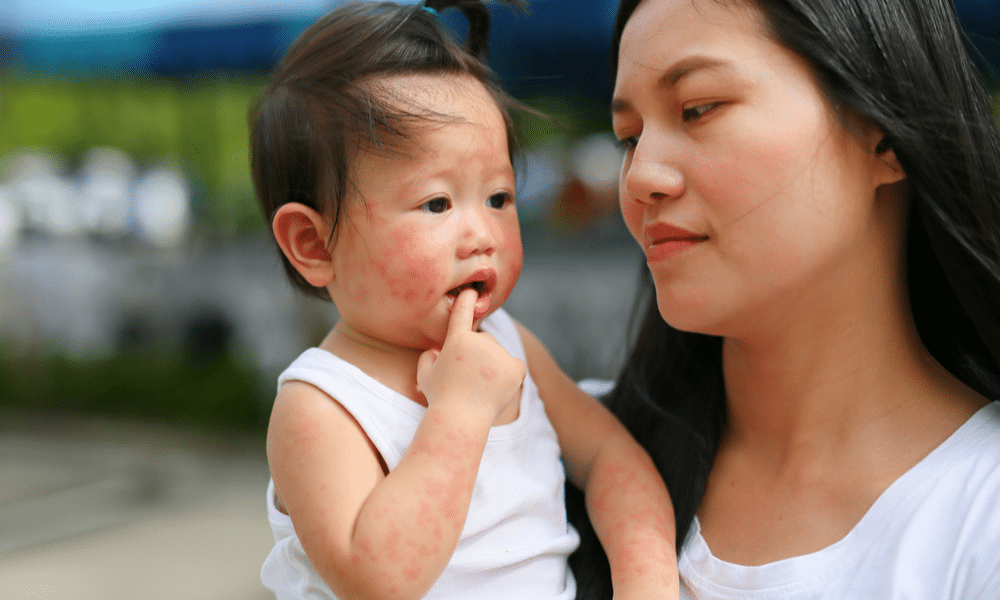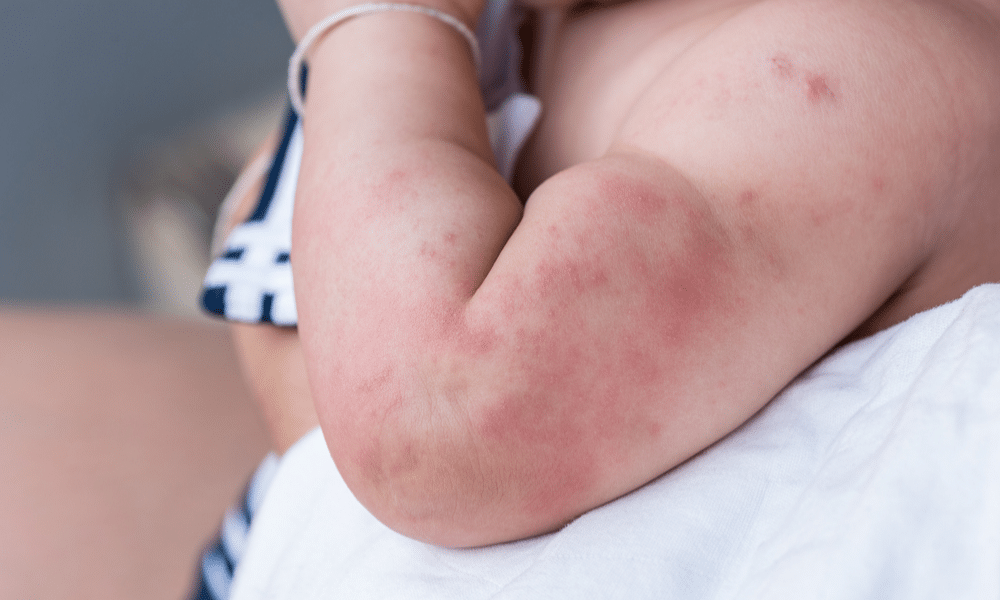What Causes A Sun Rash (Solar Dermatitis)?
Sun rash, also called solar dermatitis, refers to an allergic reaction in the form of an itchy red skin rash that develops after intense exposure to the rays of the sun. Sun rash symptoms include:
- Itchy blisters
- Bumps or tiny papules
- Hives (plaques)
- Red blotchy spots
- Skin inflammation
- Skin irritation
Solar dermatitis can break out on your skin within minutes or hours of your exposure to the sun. People who are not otherwise prone to develop sun rash may develop a sensitivity to the sun when they are on some prescription drugs or medications. Some topical beauty products may also make your skin more susceptible to sun allergy.
Solar dermatitis most often affects the face, arms, legs, back, neck and chest. Children and adolescent females are more susceptible to sun rashes. Fair-skinned people also have a higher sensitivity to the sun. Sun rashes become less common as people reach their 40s or 50s.
While a sun rash is not sunburn, it can be painful, and can cause the same skin issues later in life that sunburn does, such as wrinkling and an increased risk of cancer. If you are prone to sun rashes, you need to understand exactly how to deal with this skin condition. No one wants to spend the summer with itchy red blotches all over them!
Sun rash should not be confused with sun poisoning, which is a severe sunburn. Nor should it be confused with heat rash, also called prickly heat, which is small itchy red bumps on the skin caused by excessive sweating and blocked sweat glands. The bumps can sting and burn, causing a prickly sensation. Heat rash can develop without direct exposure to the sun, and can even be caused by electric blankets or wearing too much clothing in the winter.
Natural Remedy For Sun Rash (Solar Dermatitis)
Ever since my friend was pregnant with her first child, she would instantly develop a rash wherever her skin was exposed to the sun. Previously, she had no problems with the sun and would tan nicely. Well, there is actually an official name for this condition: solar dermatitis. The typical recommended treatment is a cool compress, oatmeal, aloe and staying out of the sun.
But none of those address a root cause – which is where I always look when treating the body. If we don’t get to the root cause or imbalance in the body, we will never have healing – symptom soothing, masking or repression, yes – but not healing.
I’m pleased to say that the first treatment I suggested to my friend worked like a charm and her sun rash problem disappeared after only two weeks on this protocol – never to return again! Can you imagine nine years of not being able to go out in the sun with any skin exposed? When you have three young children like she does, that’s a big deal.
In her case, since pregnancy triggered onset of the solar dermatitis, I wondered if there was a hormonal imbalance at work. However, I suggested we first look at balancing the gut (because whenever there’s a skin problem, you need to look to the digestive system) and taking nutrients specifically for the skin first. if that didn’t work, then we could move on to investigating the endocrine system.
Fortunately, the gut/skin regimen worked brilliantly for her sun rash, and we didn’t have to go any further. So here’s my natural treatment protocol for solar dermatitis:
1. Balance your gut flora– This means you need to get an abundance of good bacteria into your gut, rather than bad bacteria and yeast/fungi. Take one Natren Healthy Trinity Capsule (the 3-in-1 capsule) per day until you no longer get a rash when you go out in the sun. Then stay on a maintenance dose of one per day for the next six to twelve months, just to be sure. If you don’t consume any food-based probiotics (fermented veggies, homemade yogurt, etc.) then you should stay on one Healthy Trinity capsule every one to three days indefinitely. This will also provide protection against a host of other diseases and ailments. You can usually get your local health store to order Natren Healthy Trinity in for you if they don’t already carry it – but don’t substitute another brand, or you will not get the same results.
2. Take targeted nutrients for your skin– Take a high quality cod liver oil that contains ONLY naturally-occurring vitamins A and D. I like either Carlson or Nordic Naturals brands (available at most high quality health stores). Take either one teaspoon or five capsules per day. Also take vitamin D3 (cholecalciferol). Again, I prefer Carlson brand, since it is naturally-derived. You need to take the right amount of vitamin D – both according to your racial heritage and the climate you live in. Since my friend is light-skinned with blonde hair, and we live in the Pacific Northwest (not much sun – not that she could go out in the sun anyway!), she took 2,000 IU per day. With my darker skin, I take 4,000 IU Vitamin D3 per day.
3. Stop putting toxins into your body– You’re trying to help your body, rather than hinder it. So this means no processed or packaged food, no nitrates, no preservatives, no artificial flavours and —–sweeteners, no hydrogenated/vegetable oils – basically, no standard crap that everyone else eats. You also need to reduce your sugar as much as you possibly can, because sugar (and simple carbs like white flour and white rice) are the preferred food source for candida yeast/fungus and bad bacteria. Do eat fresh, organic vegetables, meat and eggs. Eat them raw or cook them in cold-pressed oils (coconut, olive oil) and organic butter. When you need a treat, use these healthy recipes for muffins and puffed squares.
I have had numerous other readers try it out since my friend healed her sun rash problem with this protocol, and so far, it has worked well. I suspect that the only instance in which it will not be sufficient is if your hormones are unbalanced.

NATURAL SUN RASH TREATMENT SUMMARY
- Balance your gut flora with high potency probiotics
- Take a high quality cod liver oil
- Take Vitamin D3
- Detox your body and avoid toxins (artificial flavours, packaged and processed foods, sugar, simple carbohydrates…)
- Eat fresh organic vegetables, eggs, meat, etc. with organic butter or cold-pressed oils



